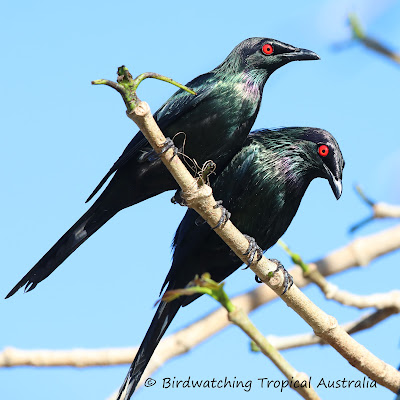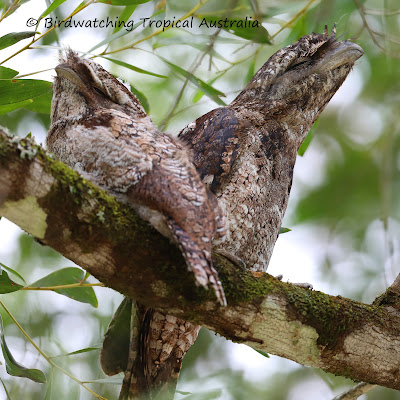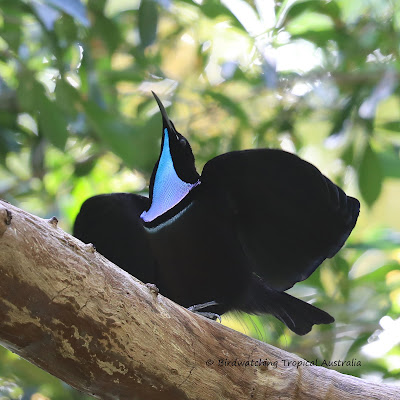Many birds were depicted and named by Gould as novelties but were later proven invalid being previously known to science either being extralimital or described elsewhere in Australia. Some of these are still attributed to him as subspecies. Read more below!
Original text researched by Rob Reed. Text edited and photos supplied by Doug Herrington. Both authors are guides for Birdwatching Tropical Australia and lead regular tours to the Tip of Cape York in December each year. You to can follow in the footsteps of Gould and other early explorers by joining one of our fabulous tours. More information is available here: https://mangroverobin.wixsite.com/cairnsbirdingtours/copy-of-iron-range-wet-season-tour
Spectacled Monarch now ssp. albiventris: A specimen provided by James
Cockerell from Cape York Tip, the albiventris subspecies was initially
felt to be a separate species thus named by Gould 1866 as such but subsequently
given back to Temminck in 1826. Gould writes: “…abundantly dispersed
over Cape York…it is stationary, breeding on the edge of the scrubs. In actions
it is a complete flycatcher, sallying forth to capture insects, returning to
the same branch…”
Australasian Figbird now ssp. flaviventris:
Named as a species by Gould in 1850 but subsequently found to be invalid and
now considered a race (ssp. flaviventris) given as Gould, 1850. Gould writes in his letterpress that “…may
be distinguished from its near ally the Sphecotheres vieillioti (now
ssp. vieillioti) by the beautiful jonquil-yellow of its under surface”. We note that jonquils are used as a yardstick for colour which
indicates the Eurocentric nature of bird collection and depiction of this era.
Fairy Gerygone now ssp. personata: Named by Gould as a species in 1866 having been sent by John and Frank Jardine of Somerset. He states “…as stated in my `Handbook`, all the known species of this genus are of small size, unobtrusive in colour…but little skilled in singing.” and “… (this species) …differs in so many particulars from all others yet discovered, that it is rendered conspicuously different…”. This was ssp. personata which was considered a separate species (from two others – the southern ssp. flavida and the New Guinea ssp. palpebrosa) for many decades but all were considered a single species by the RAOU in the early 20th century.
Marbled Frogmouth now ssp. marmoratus:
attained by MacGillivray in 1849 both male and female specimens are figured in
Gould who named it as a species but is now considered a race (ssp.
marmoratus) named to Gould in 1855, ssp plumiferus having been named
in 1832 to others in New Guinea. The modern Injinoo Ikya
language word for frogmouth is Wukugu.
Tropical Scrubwren now ssp. minimus: Gould 1875. Named as species from Somerset collected by Cockerell in 1873.
Wompoo Fruit-dove now ssp. assimilis:
Gould 1850 was named to Temminck in 1821.
Tawny-breasted Honeyeater now ssp. filiger: Erroneously named as a new species by Gould in 1850 but it was later clarified that Lesson had named the species from New Guinea in 1828.
Mangrove Robin now ssp. leucura:
provided by James Cockerell from Cape York with the information that this bird
lives exclusively in mangroves and inhabits the north of Australia from at
least Cape York to Port Essington (from where another mangled and unusable specimen
was sent to Gould previously). Named as a novel species by Gould in 1869. It was not until later that it was realised that this bird had been
named by Bonaparte from New Guinea in 1850.
Metallic Starling: Previously
named by Temminck in 1824. A nesting tree with about
50 nests was climbed by a local guide and a sack full of nests were obtained. Known
as Mooter by the local Gudang tribe. Some were kept for study, but most
had hatchlings which were thrown on the fire to be eaten slightly warmed by the
captors.
Papuan Frogmouth: Gould had representative specimens from New Guinea prior so was able to compare and found them identical. The male specimen was provided by MacGillivray and only the male is depicted in his Supplement.
Yellow-billed Kingfisher (Poditti in Gudang language): Named as a new species by Gould but later given to Lesson from New Guinea in 1827. Intriguingly Gould refers to Lesson’s depiction (he did not have his skin to study) and dismisses it as a separate species. MacGillivray reports to Gould: “…appears to be rare…of the brushes (rain forest) … (I was) attracted by the call …three or four of us remained under the tree for twenty minutes…looking intently before I discovered it on a bare transverse branch…”
Trumpet Manucode ssp. gouldi:
already known from New Guinea in 1826 this specimen was sourced from the CYT
opposite Albany Island, which is actually Somerset. Owing to the size of its wings and the proximity of New Guinea,
Gould presumed it was a migrant from that country which it is not.
Papuan Pitta: “Obtained by
Cockerell…inhabits very thick viny scrubs…its mournful whistle…is very
deceptive…a perfect ventriloquist.” and “…is much less noisy than (Noisy
Pitta), its note is less varied too…appears to make…migration…arrives in
Somerset in October and November and departs again in January and February;
whither he knows not but suspects to New Guinea.” ( This was the
first suggestion that the species is a migrant to the north of Australia. The current name
for the Australian race of this species is named after Sylvester Diggles, a
Brisbane ornithologist – Eryhtropitta macklotti digglesi.
Pale-headed Rosella: Collected
at CYT and named by Gould in 1848 as a new species. This
subsequently proved to be invalid having been named by Latham in 1790.
Olive-backed Sunbird:
Collected by MacGillivray in 1849 and described as an endemic novelty in 1850
by Gould. This however was described previously north of
Australia by Linnaeus in 1766. The Aboriginal name
for this beautiful species recorded at the time of procurement was Terridirri.
Magnificent Riflebird:
Contributed by MacGillivray in 1848 - 49 and figured and described by Gould. It was known to be described by Vieillot in PNG in 1819. The
local Gudang Aboriginal name is listed as Yagoonya. “…inhabits
the densest of brushes…Its cry is very striking…the old males…seen about the
tops of the highest trees…utter cry at intervals of from two to five minutes…If
a female is near (he) perches on a conspicuous dead twig…rapidly opening and
closing his wings…(the) feathers…produce a loud rustling noise at the distance
of hundreds of yards…” We believe this to be a very accurate description of
this species behaviour and it takes some time to accumulate this amount of
knowledge regarding its habits.
Original text researched by Rob Reed. Text edited and photos supplied by Doug Herrington. Both authors are guides for Birdwatching Tropical Australia and lead regular tours to the Tip of Cape York in December each year. You to can follow in the footsteps of Gould and other early explorers by joining one of our fabulous tours. More information is available here
https://mangroverobin.wixsite.com/cairnsbirdingtours/copy-of-iron-range-wet-season-tour
















Another fabulous background information about Cape York birds. We’ll done Rob&Doug
ReplyDeleteThank you kindly!
ReplyDelete